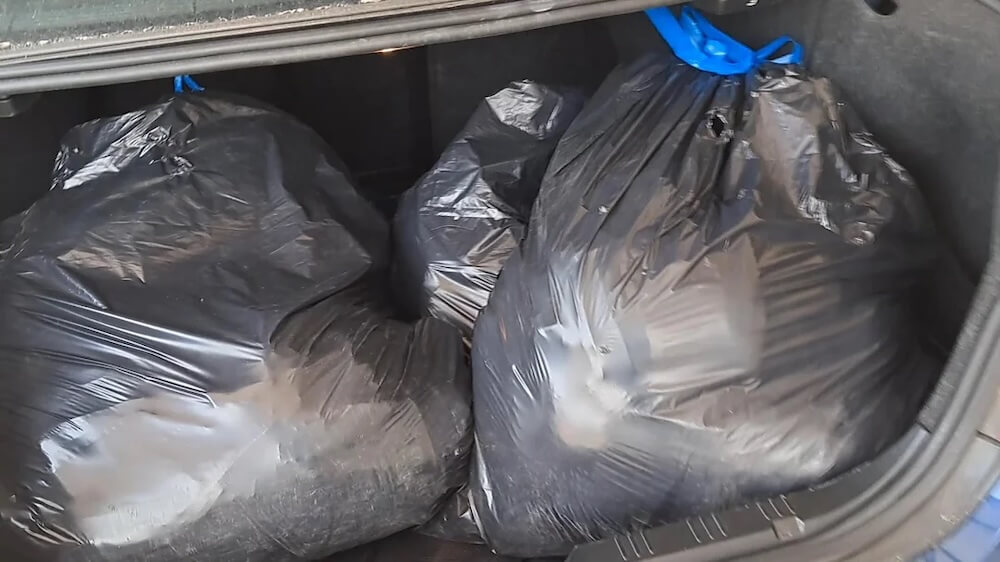What do you do with a bag of old clothes?
Many people simply drop them off at a local thrift store, which is a good way to help others out and limit waste. But what happens when even the thrift stores have too many clothes?


As one dumpster-diving Redditor discovered, many donated clothes still end up in the trash, according to their post in r/Anticonsumption.
"Rescued three giant bags worth of clothes from a thrift store dumpster," they wrote in the post. They attached photos showing what they could salvage but also how many bags were still left in the trash.
"There has to be a way to reduce fashion waste," they continued.
This problem can be a real head-scratcher. Giant fast fashion companies simply produce too many clothes for the world to keep up with. Their emphasis on profit also means they use low-quality materials that break down quickly. Since what people buy is not made to last — and since the looks that are in style change overnight — buying new things again and again seems normal.
Stay hydrated and refreshed this holiday season — without any sugar or harmful additives Nuun’s zero-sugar hydration tablets are a perfect, guilt-free way to enhance your water throughout the day. You’ll get five essential electrolytes for everyday hydration — with zero grams of sugar. Plus, Nuun tablets are certified vegan and gluten-free, and they’re the perfect size to keep in your car, purse, or anywhere you'll want a healthy, restorative drink. Learn more → |
The consequences of this consumption treadmill are dire. When textile waste ends up in landfills, materials like nylon, polyester, and spandex leach harmful microplastics into the environment. Plus, many steps of the fast fashion cycle use toxic chemicals, pollute the air, and waste water.
That's why keeping clothes out of dumpsters matters, but as the original poster pointed out, just donating to thrift stores does not always work out.
"How do we hold large clothing brands responsible? And how does individual behavior connect to the textile waste?" they asked.
These questions hit the nail on the head. The first step for anyone to tackle fast fashion waste is to stop rewarding big companies with your business. Then, do what you can to keep the clothes you already own out of a landfill. There are all kinds of ways to mend or upcycle items, and you'll save money along the way.
There's a reason dermatologists personally use this daily moisturizing sunscreen more than any other brand Dermatologists see and understand skin at a much deeper level than the rest of us, and they know that the perfect SPF both protects and corrects your skin. That's why they trust, recommend, and personally use EltaMD more than any other brand. EltaMD's clinically tested formulas are designed with dermatologists to meet the needs of any skin type or condition. They're also designed for consistent daily wear to build long-term resilience with a moisturizing, lightweight, non-comedogenic texture — plus hyaluronic acid to help reduce the appearance of fine lines and wrinkles. Learn more → |
|
Which of these factors would most effectively motivate you to recycle old clothes and electronics?
Click your choice to see results and speak your mind. |
If you have to buy something new, see if you can get a version made out of planet-friendly or recycled materials. You can even earn cash or store credit from brands like Patagonia and Levi's by swapping out old clothes.
Donating to thrift stores still helps; they just can't handle all the world's hand-me-downs. Try to reuse what you can first, and then spread donations out around town. And these shops could clearly handle more business, as the original poster proved.
A lively debate in the comments section showed that many people agreed.
"They're throwing it away because we make too much of it and we don't even sell or use half of it," one person wrote.
"I would worry about clothes produced with chemical toxins and synthetics," another added.
Join our free newsletter for good news and useful tips, and don't miss this cool list of easy ways to help yourself while helping the planet.










